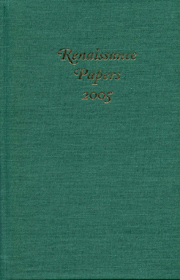Book contents
- Frontmatter
- Contents
- Renaissance Papers
- Bronzino, Castiglione, and A Self-Portrait: Re-evaluating Bronzino's Trip to Pesaro
- Tracing Astrophil's “Coltish Gyres”: Sidney and the Horses of Desire
- Shakespeare's Twins: Choric Juxtaposition
- Rhetoric and Intimacy in The Tempest
- “That Holy roome”: John Donne and the Conduct of Worship at St. Paul's Cathedral
- Conversation in Hutchinson's Order and Disorder and Milton's Paradise Lost
- Dryden on Epicoene's “Malicious Pleasure”: The Case of the Otters
Bronzino, Castiglione, and A Self-Portrait: Re-evaluating Bronzino's Trip to Pesaro
Published online by Cambridge University Press: 12 September 2012
- Frontmatter
- Contents
- Renaissance Papers
- Bronzino, Castiglione, and A Self-Portrait: Re-evaluating Bronzino's Trip to Pesaro
- Tracing Astrophil's “Coltish Gyres”: Sidney and the Horses of Desire
- Shakespeare's Twins: Choric Juxtaposition
- Rhetoric and Intimacy in The Tempest
- “That Holy roome”: John Donne and the Conduct of Worship at St. Paul's Cathedral
- Conversation in Hutchinson's Order and Disorder and Milton's Paradise Lost
- Dryden on Epicoene's “Malicious Pleasure”: The Case of the Otters
Summary
IN late 1530 the Florentine painter, Agnolo Bronzino accepted the invitation of Duke Francesco Maria I della Rovere and Duchess Eleonora da Urbino to attend their court in Pesaro. At the time of his arrival, the northern court was not only recognized as an intellectual center but also revered as both the impetus for, and origin of, Baldassare Castiglione's Il Cortegiano, the most widely read civility text of the Renaissance. As an exemplar of courtly elegance and manners, the Della Rovere court in 1530 provided a stark contrast to the more spartan court environment of Bronzino's native city, which was then only in its embryonic form, under the newly appointed first Duke of Florence, Alessandro de' Medici.
Bronzino's acceptance of the Duke and Duchess's prestigious invitation exposed the artist, for the first time, to a world of refinement, grace, learning, and courtly pursuits, informed by the ideals of Castiglione's important text. Bronzino's stay in Pesaro of just over a year visibly and permanently impacted his art, and particularly his portraiture. The changes, which are readily apparent in the portraits he painted immediately following his return, foreshadow the portrait type and style associated with Bronzino's later portraits, and in turn, Florentine portraiture of the second half of the sixteenth century as a whole.
Despite the significant body of research dealing with the works and career of Bronzino, few art historians have noted the change in Bronzino's portraiture immediately following his period in Pesaro.
- Type
- Chapter
- Information
- Renaissance Papers 2005 , pp. 1 - 24Publisher: Boydell & BrewerPrint publication year: 2006

